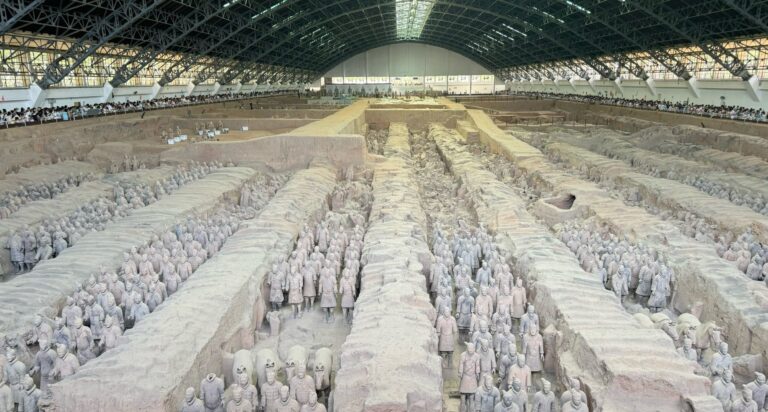Were the terracotta soldiers buried alive?
the Terracotta Army: The Terrifying Legend of Human Burial vs The Real Code of Archaeology
1: The world-shaking underground army and the mystery of the living terracotta warriors
In 1974, a farmer digging a well in Lintong, Shaanxi Province, China, accidentally uncovered a military empire that had been dormant for 2,000 years: a subterranean army of more than 8,000 life-size terracotta warriors facing east, as if they were ready to conquer the netherworld at the beck and call of the First Emperor of Qin. The discovery shocked the world, but along with the shock came a speculation full of gothic horror – were these lifelike terracotta warriors cast from the living? Hollywood movies and urban legends have dramatized the concept of “living terracotta warriors”: artisans wrapped living people in clay, kept them in a fighting stance, and then burned them at high temperatures to create “soulful” funerary objects. Such speculation is consistent with the Western imagination of the mysterious East and alludes to the primal fear of death and eternity. But the truth is much deeper than legend.

2: Archaeological Evidence for the Accurate Deconstruction of the “Buried Alive” Theory
Modern technology provides the key to solving the mystery: CT scans show that the Terracotta Warriors are completely hollow, with no traces of human remains. Clear fingerprints remain on the interior walls of the terracotta warriors, suggesting that they were made by artisans who assembled the modules by hand. More critically, carbon 14 dating technology confirms that the age of the clay samples centers around 246-210 BC, which is a perfect match with the construction time of the Qin mausoleum. If there is a live burial phenomenon, the clay should have residual organic matter from the 3rd century BC, but the test results only show later restoration materials. The restoration process of the kneeling terracotta warriors is an archaeological textbook: when archaeologists cleared the thousand years of dust, they found that under the painted layer of the terracotta armor, the names of the makers, such as “Gongjiang”, etc., engraved by the craftsmen with knives were preserved in their entirety – an imprint of life that could not be explained by the theory of live burials.
3: The technical code and cultural logic of the Qin Dynasty funeral system
“The concept of funeral and burial of the Qin Dynasty is the cultural key to unlocking the mystery of the Terracotta Army. The Qin people believed that the emperor needed to continue his rule in another world after death, so they used terracotta figurines instead of living people to be buried, which not only demonstrated the centralized military system, but also avoided the risk of social unrest caused by living people being buried. This “simulated reality” of burial art reaches an astonishing height: each terracotta figurine’s hairstyle, armor, and facial expression are all individually designed, and even the density of the stitches on the soles of the shoes is exactly the same as that of unearthed Qin Dynasty hemp shoes. The bronze weapons in the Terracotta Warriors pit have been oxidized by chromium salt and have not rusted for two thousand years, which is a “forward-looking technology” that confirms the military strength of the Qin Dynasty as recorded in the Records of the Grand Historian, which is “the same as the world”.

4: Beyond the legend of the civilization dialogue
When the American audience gazed at the Terracotta Army, they were actually traveling through a civilization dialogue across time and space. These terracotta warriors are not a footnote to the horror of the legend, but a three-dimensional expression of China’s “great unity” idea: from the kneeling terracotta warrior armor on the cloud pattern, to the general terracotta boot soles non-slip pattern, every detail is telling the Qin people “standardization” and “individuality” coexist in the philosophy of creation. As the director of the Metropolitan Museum of Art’s Asia Department said, “The Terracotta Warriors show us how ancient China transformed power into eternity through art.” Today, when 3D printing technology attempts to replicate the Terracotta Warriors’ paintings, mankind finally understands that the codes in the clay are not only Qin Shi Huang’s struggle against death, but also the crystallization of Chinese civilization’s wisdom of “carrying the way through artifacts”.
Conclusion:
The true miracle of the Terracotta Warriors lies not in the fact that they were made by living men, but in the fact that they allow the viewer of each era to read the codes of a different civilization. For modern American readers, these terracotta warriors may be able to provoke deeper thought: as technological iterations continue to reconfigure human cognition, how do we safeguard those cultural genes that transcend time? After all, just as the Qin mausoleum palace is still buried in the unknown, human exploration of the truth of history, always on the road.







